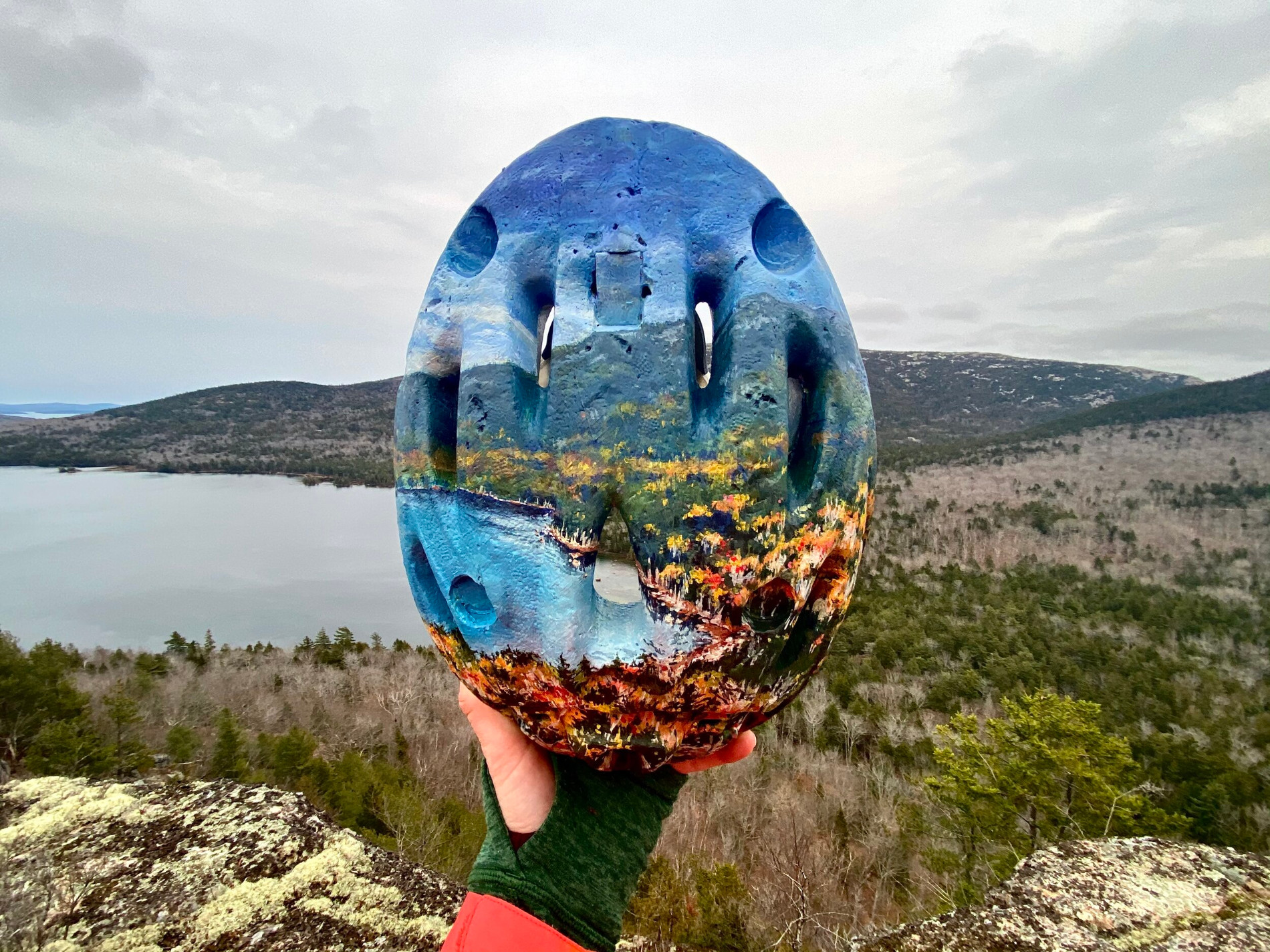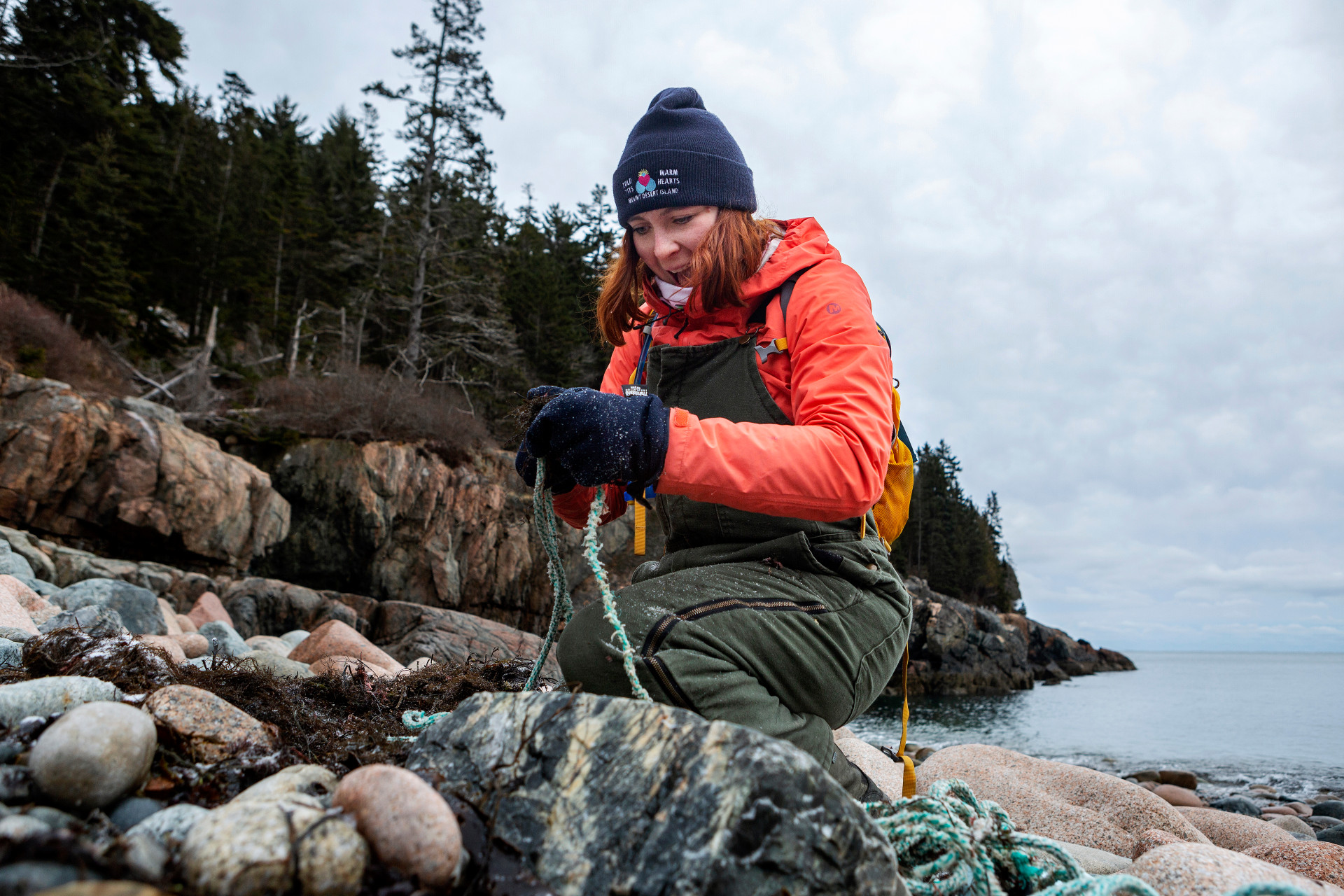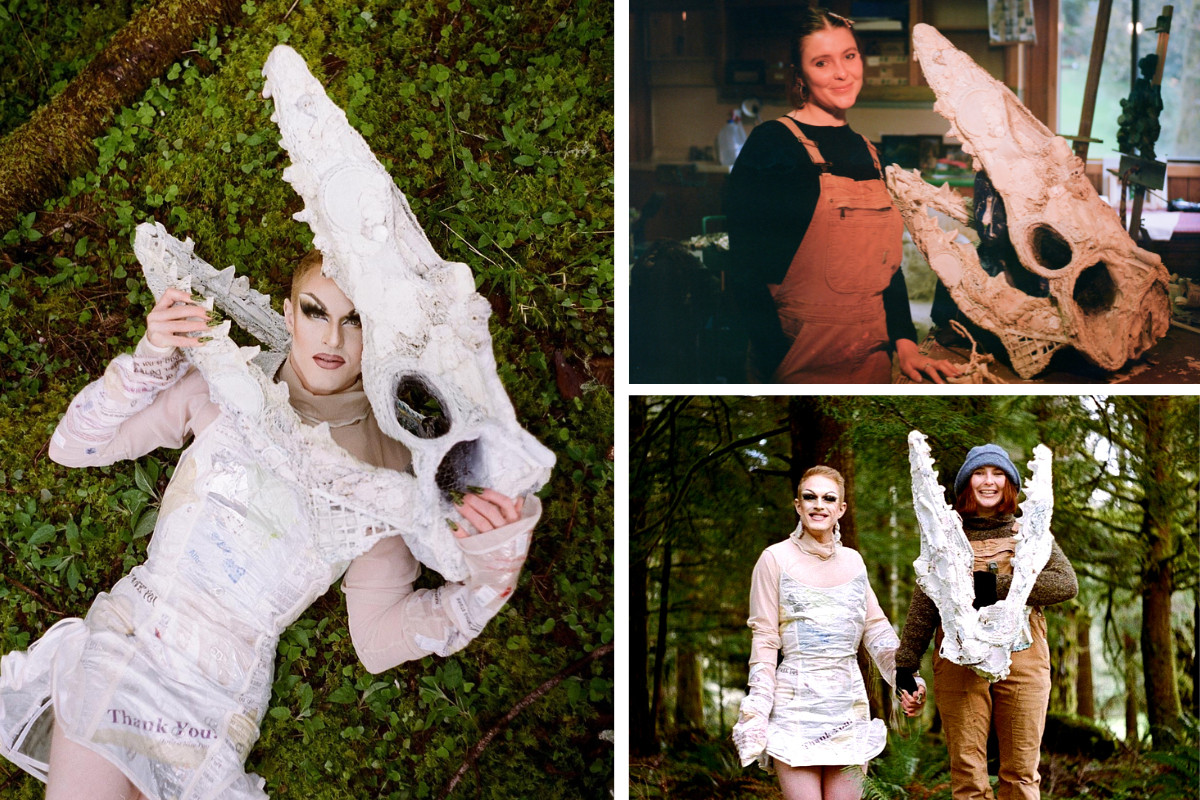One Person’s Trash is Another Person’s Treasure
Mariah Reading Creates Impressionist Paintings on Trash to Educate on the Harms of Pollution and Climate Change
October 24th, 2022
Mariah Reading Creates Impressionist Paintings on Trash to Educate on the Harms of Pollution and Climate Change
October 24th, 2022

A bike helmet found in the Eagle Lake Parking lot that Reading painted and then wore as she hiked to an overlook to take this photograph. (Photo courtesy Mariah Reading)
BY JULIA WALKER THOMAS
Artist Mariah Reading is no stranger to Acadia. Growing up in Bangor, she visited the park with her parents on weekends and in the summer, on field trips, and after getting her driver’s license, with high school friends going to Sand Beach and Cadillac Mountain.
After high school, Reading studied art at Bowdoin College, focusing on painting, specifically landscapes. In 2016 while in a sculpture class, she became very aware of how much trash traditional art materials generate.
“The year I was in that class was the same year as the National Park Centennial, so I was acutely aware of the parks and this helped me pivot to eco art, when the parallel between painting landscapes and feeding landfills became overwhelmingly apparent,” Reading said.
Later that year, after getting a job in California as a teacher, she planned a road trip across the country, stopping at several national parks and picking up trash along the way. The trip started in Acadia National Park, where she collected her first piece of trash, thus beginning her Recycled Landscapes series. Her first piece of trash-turned-art was marine debris from the Schoodic Peninsula.

Artist-in-Residence Mariah Reading stands next to a washed-up aquaculture box that she transformed into a work of art. (Photo courtesy Mariah Reading)
An Artist-in-Residence at Acadia in the Fall of 2019, Reading spent the 14 days of her residency at Schoodic, Isle Au Haut, and the Brown Mountain Gatehouse, painting trash (mostly marine debris) she found along her treks through the park. Her canvases included ropes, a sweatshirt, parts of lobster traps, a buoy, a frisbee, and a giant aquaculture box. On them she painted the scenes near where they were found.
It wasn’t until Reading returned to Acadia in 2020 as an interpretive ranger, co-hosting programs like Stars
Over Sand Beach, that her knowledge, understanding, and connection to the park grew deeper. She is thankful for that season spent working as a ranger because she was able to reconnect with her home and learn more about it.
“Before I worked as a ranger, I would navigate through Acadia and the coastline and not fully understand geology, ecology, or the indigenous presence here. It was impactful for me to work here and reclaim myself as a Mainer and really appreciate this place,” she said.
The Recycled Landscapes series has remained fresh for Reading over the years because “it’s really this improvised thing—it’s always new. I’m constantly looking for shapes in the landscape.” She looks for recognizable silhouettes like water bottles, shoes, and buoys because these hard surfaces also take paint well.
By blending the object and landscape together, Reading hopes people will see their own habits, waste cycles, and the national parks they love reflected in the objects. “I’m an ‘imperfect environmentalist,’ and I’m working slowly toward more sustainable choices. I hope viewers of my work also feel inspired to consider changes they can make in their own lives to better our environment.”

Artist Mariah Reading works to untangle a piece of fishing rope she found while looking for discarded trash in Acadia National Park. (Photo by: Ashley L. Conti/Friends of Acadia)
Like the ending message in her favorite book growing up, Miss Rumphius, Reading says she’s tried to create art that “makes the world more beautiful,” and this is what drives her forward to keep creating, big and small, to help inspire others to also “turn ugly, discarded objects into things of beauty.”
Reading currently serves as an interpretive ranger at Isle Royale National Park in Michigan. She says that though Isle Royale is her “heart park” for now, she calls Acadia her “winter home,” where she likes to “hunker down and get a lot of painting done after focusing on the park service all summer.” She plans to live on Mount Desert Island during the winter, painting and visiting with family, including a brand-new niece. “MDI is my stability among the chaos,” she said.
What’s next in the progression of her work? Reading wants to combine art with her love of water. She has already begun painting scenes from canoes and kayaks and aligning (photographing her paintings against the actual landscape it was inspired by) while swimming.
She hopes to get scuba certified to photograph the underwater scenes she has painted on trash collected while in the water, to bring more attention to marine debris and ocean trash.
See more of Mariah Reading’s work on her website: www.mariahreadingart.com
Video by Ashley L. Conti/Friends of Acadia
Earlier this year, Reading worked with the drag queen, environmentalist, and social media personality, Pattie Gonia. They collaborated to create an “Our Trash is Our Fossil” drag look using found beach trash that Reading sculpted into a dinosaur skull with a matching dress made of trash designed by another artist.
The idea behind the project is to bring attention to how long it takes for trash to break down. “Our bones won’t be the only fossils we leave behind. Our trash will, too. Is this what we want our legacy to be?,” they ask. The collaborators hope this project drives home the impacts our everyday choices make and how those choices are related to climate change.

Mariah Reading and Pattie Gonia pictured with the dinosaur skull Reading created from found trash. (Photos courtesy Mariah Reading)
JULIA WALKER THOMAS is Friends of Acadia’s Visual Storytelling & Creative Projects Manager.